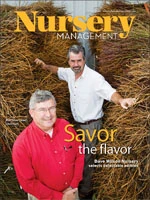|
Phytophthora root rot is caused by several species of Phytophthora, although in the southeast P. cinnamomi is the most important. Other species associated with diseased ornamental plants include P. cactorum, P. cambivora, P. citricola, P. citrophthora, P. cryptogea, P. dreschleri, P. hedraiandra, P. megasperma, P. nicotianae, as well as several undescribed Phytophthora species.
Hosts
Phytophthora and Pythium species attack a wide range of woody ornamentals, including species and cultivars of Abies, Acer, Aesculus, Aucuba, Betula, Buddleia, Buxus, Calluna, Camellia, Castanea, Cedrus, Cornus, Cotoneaster, Craetegus, Cupressocyparis leylandii, Eleagnus, Euonymus, Forsythia, Gledistia, Ilex, Juglans, Juniper, Kalmia, Larix, Leucothoe, Ligustrum, Liquidambar, Magnolia, Malus, Nyssa, Picea, Pieris, Pinus, Platanus, Prunus, Pyrus, Quercus, Rhododendron, Salix, Syringa, Thuja, Tsuga, Ulmus, Vaccinium, Wisteria and others.
Distribution and importance
Phytophthora root rot is a serious, widespread and difficult to control disease affecting a diverse range of ornamental and agronomic plants worldwide.
Pythium root rot is typically not as common on woody ornamentals. Pythium species are most well-known for their ability to cause damping-off during seedling production.
Phytophthora and Pythium kill the roots and crown of infected plants. These pathogens markedly reduce the volume of the roots that the plant uses to absorb water and nutrients.
Symptoms include yellow or bronze foliage, wilting, branch dieback, poor plant vigor, and sometimes death. Downward rolling of leaves is also an early symptom on rhododendron. Liners or container-grown plants can remain symptomless until after transplanting into larger containers or landscape beds.
Roots of affected plants are cinnamon-red to black in color and lack white growing tips. Often, the outer surface of the root can be pulled away from the inner core, also called ‘root sloughing’, and feeder roots are typically absent or discolored.
Butterscotch discoloration of the tissues or oozing, water-soaked cankers may be apparent under the bark of the plant around the soil line. These symptoms are often not apparent until the roots are heavily infected.
Many of the symptoms of root rot can be easily confused with those of a nutritional disorder, over- or under- watering, or a number of other factors, hence a confirmation of the pathogen is important.
Disease cycle
Phytophthora and Pythium require extended periods of high soil moisture to cause disease. During the growing season when temperatures rise, mycelia or chlamydospores germinate and produce sporangia.
Phytophthora and Pythium species can spread through contaminated substrate or supplies (including re-used media and pots), with infected nursery stock or by contaminated irrigation water.
Recent research has found some Phytophthora and Pythium species can be spread by fungus gnats and shore flies.
Control measures
Managing root rot requires an integrated pest management (IPM) approach, as no single control strategy will prevent or control this disease.
Cultural control:
- Purchase healthy liners and container-grown plants. Prevention is the key to controlling root rot.
- Avoid excessive irrigation.
- Avoid using fine materials in substrate, such as peat moss or clay, which may settle and slow percolation of water. Substrate can have a significant impact on the occurrence and severity of root rot. Container stock that is grown in compacted, poorly drained media with little pore space is most likely to suffer from root rot. The substrate should drain rapidly and have about 20 to 30 percent air space (air filled porosity).
- Maintain plants in well-drained areas to prevent water ponding around plants. Field sites and container areas should be crowned or sloped to speed the run-off of water. A drainage system should be designed to quickly move water around or away from production areas.
Do not grow shallow-rooted trees and shrubs in areas that flood. Also, container areas should be covered with plastic or weed barrier and topped with a layer of gravel, oyster shell, or similar coarse material.
- Remove infected plants immediately to limit the amount of pathogen inoculum in the growing area.
- Sanitize equipment and supplies between crops.
- Components for container potting media should be stored on concrete pads to reduce contamination.
- Avoid reusing cell packs or containers unless they are first cleaned of organic material and then soaked in disinfectant or steamed.
- Evaluate irrigation water to ensure it is not contaminated with the pathogens. Recycled irrigation water should be sanitized with chlorine or other disinfestation methods. Recent research has shown Phytophthora and Pythium incidence in nurseries is correlated with the use of recycled water.
Chemical control:
- Chemical control of Phytophthora or Pythium root rot is successful only when integrated with BMPs.
- Fungicides work better as prophylactic treatments.
- Incorporated fungicides are usually more uniformly distributed throughout the substrate or soil and may provide better protection.
- If a root rot fungicide was not incorporated into the substrate, begin drenches or foliar sprays immediately after plants have been transplanted.
- Soil drenches usually provide better protection from root rot than foliar sprays.
- Treatment schedules and rates will depend on the plant, the level of disease pressure and the fungicide used.
Critical issues and needs:
- Phytophthora-tolerant varieties of rhododendron and azalea have been reported but these varieties are difficult to find and most are not cold-hardy.
- Develop and evaluate plant material for resistance to root rot.
- More research on effective chemicals for Pythium root rot is needed.
- Offer research and education on cost-effective water disinfestation methods.

This article was adapted from the Pest Management Strategic Plan workshop at the North Carolina Mountain Horticultural Crops Research and Extension Center, Mills River, N.C.; www.ces.ncsu.edu/fletcher.
|







